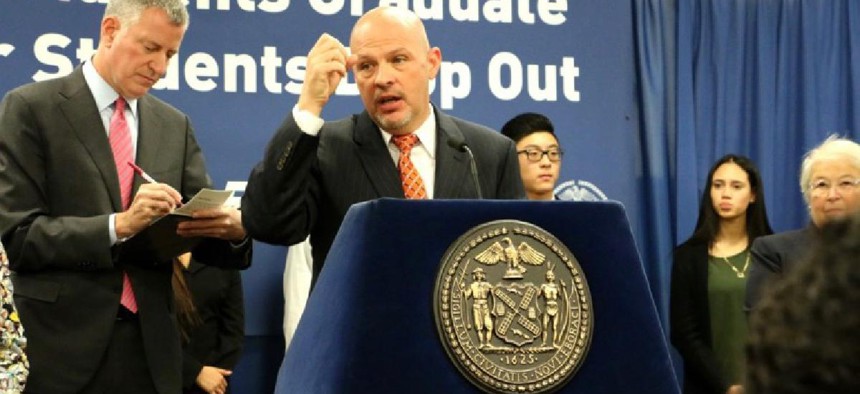When the dust settled after this year’s legislative session, New York state’s 2015 teacher evaluation law had been effectively dismantled.
That evaluation system, designed to give more weight to standardized test scores, could no longer include grades 3-8 math and English state tests — and districts were given an extra few months to figure out how to fill that gap.
Now, details are emerging about what that might look like in New York City.
In an email sent to United Federation of Teachers chapter leaders, UFT President Michael Mulgrew said the union is currently negotiating with the city to add more “authentic” measures of student learning in teacher evaluations.
“Our goal in the current negotiations is to have as many options as possible of authentic student learning not based on standardized test scores,” the email reads.
Mulgrew reiterated that point at a UFT meeting last week, where he reportedly told UFT chapter leaders he would not agree to a new teacher evaluation system until he had secured more such “authentic” student learning measures. (Chapter leader Arthur Goldstein blogged about it after the meeting.)
The union did not comment further on what those assessments might include, since they are still hashing out the details of the new evaluation system with the city. The new evaluations must be finalized by the end of December, but in Mulgrew’s email to chapter leaders, he said he hopes to finish earlier in the school year.
New York City already has a system of exams, beyond the state’s traditional standardized tests, that schools can choose to factor into their teacher evaluations. These exams are called “Measures of Student Learning” or MOSLs, and they take a number of forms, including essays, oral reading assessments, or performance-based music exams. In the email to chapter leaders, Mulgrew indicated that MOSL options might expand before the end of negotiations.
In an April op-ed in City & State, Mulgrew called for more semester-long assessments. “As New York weans itself off its reliance on fill-in-the-bubble tests, it should be looking at strategies like projects and portfolios that cover an entire semester or even a year of work and offer a real assessment of what students can do,” he wrote.
Jake Jacobs, an art teacher at New Directions Secondary School in the Bronx, said assessments that show learning over time would be a more “authentic” way to measure a teacher’s work.
“What ‘authentic’ assessments mean in my department is actual student work, sometimes with teacher feedback on it, sometimes showing progress,” Jacobs wrote in an email. “Maybe in a portfolio, digitally, or on display where it can be analyzed to determine what’s going on in that classroom over time.”
Experimenting with new types of assessments is in line with the State Education Department’s priorities. Commissioner MaryEllen Elia wanted New York to participate in a pilot that will allow seven states to experiment with new types of assessments, though that project may be derailed by a lack of funding.
State officials have to approve any new assessments used to evaluate teachers, but so far they seem open to more creative options. Officials said they welcome applications that include more authentic measures of student learning, as long as those assessments are valid and reliable.
This article was first published on Chalkbeat New York on September 20.


